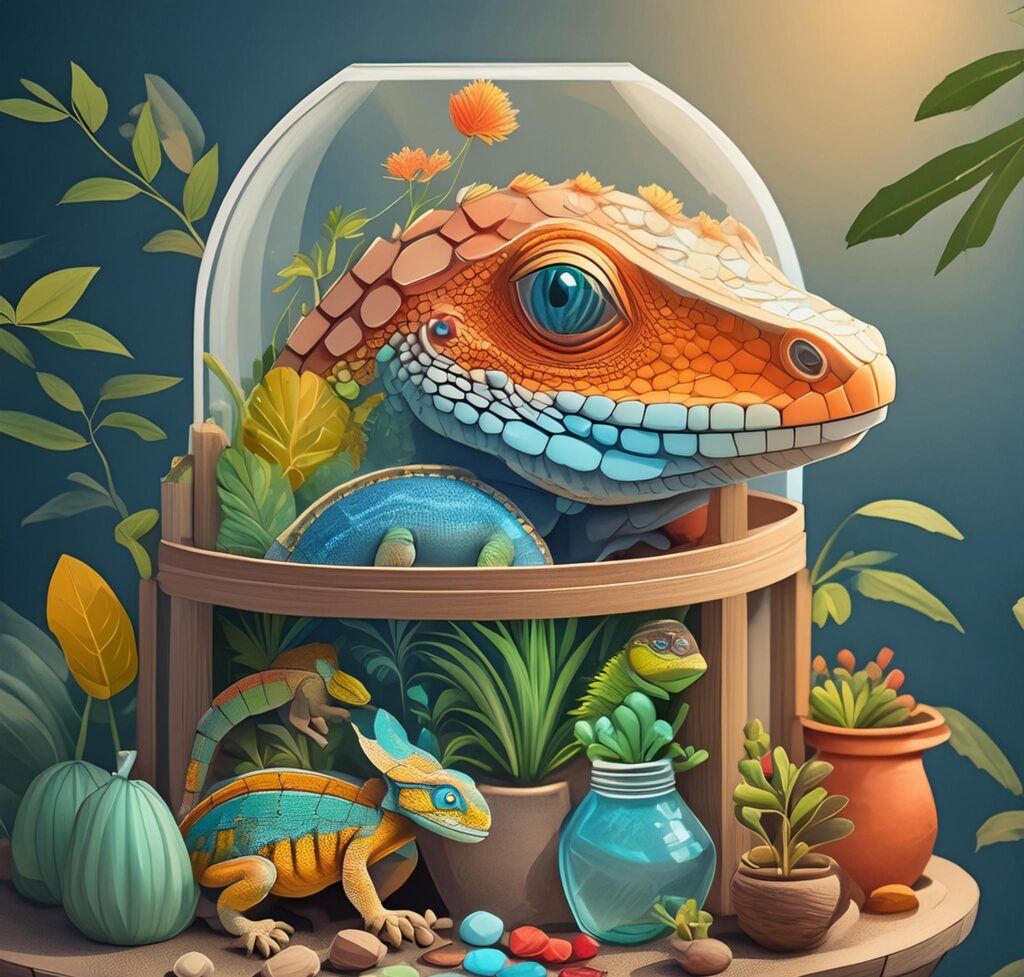Enrichment and Mental Stimulation in Captive Reptiles

In today’s article, we explore the importance of enrichment and mental stimulation in captive reptiles. Reptiles, with their unique behaviors and habitat requirements, need more than just a tank and basic care to thrive in captivity. Providing them with an enriched environment is not only beneficial for their physical health but also crucial for their mental well-being.
Understanding the Natural Behaviors and Needs of Reptiles
To ensure the well-being of captive reptiles, it is essential to understand their natural behaviors and needs. Reptiles, like snakes, lizards, and turtles, have specific instincts and behaviors that they rely on in the wild. For example, many reptiles are nocturnal and require a dark and quiet space to rest during the day. Others may need access to water for swimming or basking spots for thermoregulation.
By understanding these natural behaviors, reptile owners can create an environment that closely mimics their natural habitat. This includes providing hiding spots, climbing structures, and appropriate substrate for burrowing. When reptiles can engage in these natural behaviors, they experience less stress and are more likely to thrive in captivity.
Types of Enrichment Activities for Reptiles
Enrichment activities play a crucial role in keeping captive reptiles mentally stimulated. There are several types of enrichment that can be introduced to reptile enclosures. One popular option is the use of hiding spots. Reptiles, especially snakes, rely on hiding to feel secure. Providing multiple hiding spots, such as caves or hollow logs, allows reptiles to retreat and feel safe.
Climbing structures are another important form of enrichment for arboreal reptiles, such as tree-dwelling lizards. Branches, driftwood, or specially designed reptile hammocks can be added to the enclosure, allowing the reptile to exercise and explore their vertical space. This type of enrichment also encourages natural behaviors like climbing and basking.
Toys can also be used to stimulate reptiles mentally. For example, puzzle feeders can be filled with food, encouraging the reptile to problem-solve and work for their meal. Rolling balls or objects with hidden treats can also provide mental stimulation. It’s important to choose toys that are safe for reptiles and free of small parts that could be ingested.
Creating a Stimulating and Enriching Reptile Enclosure
Creating a stimulating and enriching reptile enclosure requires careful planning and consideration. The size of the enclosure should be appropriate for the species, allowing enough space for exercise and exploration. It’s important to provide a variety of environmental features, such as rocks, branches, and plants, to mimic the reptile’s natural habitat.
Temperature and lighting are also important factors to consider. Reptiles require specific temperature gradients and UVB lighting to maintain their health. Providing the correct lighting and temperature gradients not only ensures their physical well-being but also encourages natural behaviors and activity.
In addition to physical features, the enclosure should be designed to provide mental stimulation. This can be achieved through the use of different textures, scents, and even visual stimuli. For example, adding natural elements like rocks with interesting textures or plants with aromatic leaves can provide sensory enrichment. Reptiles can explore these elements, which stimulates their senses and keeps them engaged.
DIY Reptile Enrichment Ideas
For reptile owners looking for budget-friendly enrichment options, there are plenty of DIY ideas to consider. One simple idea is creating a foraging station. This can be done by hiding food items or treats throughout the enclosure, encouraging the reptile to search and hunt for their meals. This mimics natural foraging behaviors and keeps the reptile mentally stimulated.
Another DIY option is creating a basking platform with a built-in water feature. This provides a multi-functional area for the reptile to bask, hydrate, and explore. By incorporating rocks, plants, and even small waterfalls, reptiles can engage in natural behaviors like basking and drinking.
Feeding Strategies for Mental Stimulation in Reptiles
Feeding time can be a great opportunity to provide mental stimulation for captive reptiles. Instead of simply placing food in a dish, consider using feeding strategies that encourage natural behaviors. For example, offering live prey, such as crickets or mealworms, allows reptiles to exercise their hunting instincts.
Another strategy is using food puzzles or slow feeders. These devices require the reptile to work for their food, promoting problem-solving and mental engagement. Puzzle feeders can be as simple as placing food in a small container with holes, requiring the reptile to manipulate the container to access the food.
Behavioral Signs of a Mentally Stimulated Reptile
A mentally stimulated reptile will exhibit certain behavioral signs. They will be more active and curious, exploring their environment and engaging in natural behaviors. A mentally stimulated reptile may also display less aggression towards humans or other reptiles. They are more likely to be alert and responsive to their surroundings.
It’s important to note that every reptile is different, and their behavior may vary based on their species, age, and individual personality. However, a mentally stimulated reptile generally shows signs of contentment, curiosity, and a healthy appetite.
Common Mistakes to Avoid in Reptile Enrichment
While enrichment is crucial for the well-being of captive reptiles, there are some common mistakes that reptile owners should avoid. One mistake is overstimulation. Reptiles can become overwhelmed if their enclosure is too cluttered or if there are too many new elements introduced at once. It’s important to introduce enrichment gradually and observe the reptile’s response.
Another mistake is providing inadequate hiding spots. Reptiles rely on hiding to feel secure, and a lack of hiding spots can lead to stress and anxiety. Ensure that the enclosure has multiple hiding spots that are easily accessible to the reptile.
Reptile Enrichment Products and Toys on the Market
For reptile owners who prefer ready-made enrichment options, there are a variety of reptile enrichment products and toys available on the market. These products are specifically designed to provide mental stimulation and environmental enrichment for captive reptiles.
Some popular options include puzzle feeders, climbing structures, and interactive toys. Puzzle feeders can be filled with food or treats, encouraging the reptile to problem-solve and work for their meal. Climbing structures provide opportunities for exercise and exploration, mimicking natural behaviors. Interactive toys, such as rolling balls or objects with hidden treats, keep reptiles mentally engaged.
Conclusion: The Long-Term Benefits of Enrichment and Mental Stimulation for Captive Reptiles
In conclusion, enriching the lives of captive reptiles through mental stimulation and environmental enhancements is not only a responsible practice but also a rewarding one. By understanding the natural behaviors and needs of reptiles, providing appropriate enrichment activities, and creating a stimulating enclosure, reptile owners can greatly improve the well-being of their reptilian companions.
Mental stimulation not only prevents boredom and reduces stress but also promotes natural behaviors and positive changes in reptile behavior. It helps reptiles adapt to new environments, reduces the risk of stereotypic behaviors, and enhances their overall quality of life.
By incorporating enrichment and mental stimulation into the daily routine of captive reptiles, owners can create a thriving and fulfilling environment for their scaly friends. So, let’s embrace the importance of enrichment and make a positive impact on the lives of captive reptiles.
Must Read: Impact of Enclosure Size on Reptile Behavior and Health

What do you think?
Show comments / Leave a comment